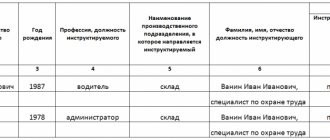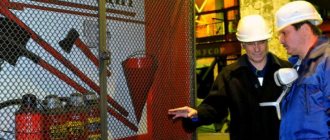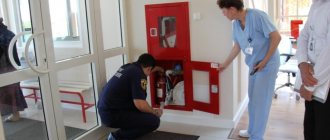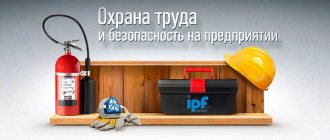Wherever people work, fire safety measures must be strictly taken into account and observed. Therefore, employees, regardless of their position, regardless of the subject of activity (legal entities, local governments and entrepreneurs) must undergo training in safety rules. The regulatory documents clearly state that any employee is allowed to work if he has undergone fire safety training.
There is even a Federal Law numbered 69-FZ (new edition published in 2020), which is called “On Fire Safety”. It states that fire safety training should be provided on a regular basis. And the head of the enterprise is responsible for this, who, by his order, establishes when and how this training will take place.
It should be noted that the term “fire safety instruction” does not mean a one-time lesson. This is a multi-stage process that occurs throughout a person’s work. It is legalized by Order of the Ministry of Emergency Situations number 645 (new edition of 2010), which clearly outlines the types of fire safety instructions.
Fire Safety Program
The program is developed by the department responsible for labor protection at the enterprise. All items are compiled in accordance with fire safety standards, taking into account its specialization. After the program is ready, it is approved by the head of the organization or educational institution. The frequency of fire safety briefings is assigned and prescribed in this program. Typically, managers combine fire prevention and elimination measures and safety measures. Fire safety training is a series of actions that are carried out at each enterprise in order to familiarize personnel with the actions that must be taken in the event of a fire. Also during the classes, workers are taught how to properly use protective equipment and all safety requirements are explained.
Actions of responsible persons in the event of a fire
In the event of a fire, responsible persons are required to act in accordance with the instructions. First of all, they need to call the appropriate fire department and report the fire. Then you should organize the evacuation of the company's employees (in accordance with established plans), save all valuable documentation and wait for the arrival of the fire brigade. By the way, it is recommended to hold fire safety days at any enterprise, during which people can be instructed on evacuation rules. This can be done at least twice a year.
Fire safety briefings: types, necessity
When hiring employees, the boss must familiarize new personnel with the basics and requirements of industrial safety and health at the enterprise. What every worker should know:
- PB rules.
- How work processes take place at the enterprise.
- The design of the equipment and the principle of its operation.
- How fire safety equipment is used.
- What to do in case of fire.
It is the manager who is responsible for familiarizing employees with this information. The boss also determines:
- Frequency of fire safety briefings.
- The time when the briefing should take place.
- In what order will the classes be held?
Fire safety briefings are divided into 5 categories:
- Introductory - for each person when applying for a job.
- Primary - an authorized person conducts on-the-job training at the time of hiring.
- Repeated - twice a year, an authorized person holds special events, the purpose of which is to remind the entire team of fire safety rules.
- Unscheduled - usually takes place without warning, they test knowledge and requirements of industrial safety.
- Targeted - prescribed if the need arises.
Regulations on the procedure for conducting briefings in preschool educational institutions
When carrying out such events, the management of the organization, along with responsible persons, pursue the following goals and objectives:
- providing personnel with information about the marking of areas of the enterprise to understand the evacuation plan;
- providing information on the degree of explosion hazard and the likelihood of fire;
- informing about the practical application of fire protection systems;
- consolidation of acquired knowledge in practice through special organized exercises.
Targeted briefings are carried out individually - with one worker or a group performing the work. The workers are instructed by the person who issues the work order, or, regarding power plants, by the work manager.
Journals are legal documentation, and therefore must be drawn up and filled out in strict accordance with legal requirements. Each document must be laced and numbered. Our website contains a wide selection of instructions and other documents regulating electrical and fire safety issues.
Fire safety training usually takes place in a room specially equipped for this purpose. Usually, after the theoretical part, employees must complete practical tasks.
Initial briefing is carried out upon hiring. The main purpose of the initial briefing is to introduce the employee to the fire safety rules in his workplace. Usually, the first briefing is carried out for each employee separately, but it is allowed to arrange initial briefings with a small group of people if they are all engaged in the same activities at work.
When hiring employees, the boss must familiarize new personnel with the basics and requirements of industrial safety and health at the enterprise. What every worker should know:
- PB rules.
- How work processes take place at the enterprise.
- The design of the equipment and the principle of its operation.
- How fire safety equipment is used.
- What to do in case of fire.
This type of instruction must be completed by all newly hired employees of the enterprise, business travelers, temporarily hired personnel, as well as trainees and students undergoing practical training. This instruction should be carried out in a specially equipped place or in a corner with visual aids.
This instruction is carried out in case of changes in the technological process, the use of new fire-hazardous equipment, planning changes in facilities, the introduction of new installations of fire automatics, gross violations of fire safety and the technological process that led to a fire or fire.
Conducting this briefing is also the responsibility of the head of the unit; the fact of conducting it is recorded in the journal with the signatures of the instructed and the instructing.
The need to conduct fire prevention propaganda and training in fire safety measures is directly indicated by 69-FZ “On Fire Safety”.
Fire safety standards “Training in fire safety measures for employees of organizations” establish fire safety requirements for organizing training in fire safety measures for employees of organizations.
It is carried out with each employee of the enterprise/organization in order to check/monitor knowledge in the field of fire safety and actions in the event of a fire.
The most useful thing in the article: “The procedure, timing and frequency of repeated fire safety briefings + samples” with a full assessment of the information and conclusions. The lawyer on duty can answer all questions.
The director's order describes the procedure for conducting repeated fire safety training:
- Theoretical part. Employees gather together and the instructor provides an oral introduction to the material. Talks about the requirements of the Ministry of Emergency Situations, accepted standards and other details of fire safety.
- Demonstration of the protective equipment available in the company with a description of their operation. You are welcome to use them as examples.
- Explanation of the details of fire-hazardous mechanisms (if any at the company) and the properties of flammable liquids.
- Practical training - The instructor shows students safe escape routes and what skills they should use to prevent a fire from starting or spreading. Shows how fire extinguishers and other fire extinguishing equipment work.
Fire safety briefings are divided into 5 categories:
- Introductory - for each person when applying for a job.
- Primary - an authorized person conducts on-the-job training at the time of hiring.
- Repeated - twice a year, an authorized person holds special events, the purpose of which is to remind the entire team of fire safety rules.
- Unscheduled - usually takes place without warning, they test knowledge and requirements of industrial safety.
- Targeted - prescribed if the need arises.
The procedure is reflected in the program approved by the manager. It must comply with the standards of the Ministry of Emergency Situations and answer the question of how often to conduct fire safety training, and disclose other details of the program. There are five categories in total:
- induction - it is arranged for every new employee;
- primary - carried out by an authorized person for the team at their workplace;
- repeated - carried out by a consistently responsible employee in order to remind everyone of the safety rules;
- unscheduled - carried out suddenly at the direction of the head of the company (testing citizens’ knowledge of industrial safety requirements);
- targeted - assigned as needed.
The instruction is carried out by the official responsible for industrial safety, appointed by order, or by a safety/safety engineer at large enterprises.
Both permanent and temporary employees of enterprises should know:
- fire safety requirements;
- technological production processes, their features;
- equipment, its structure and principle of operation;
- rules for the use of fire protection equipment;
- actions and measures taken in the event of a fire.
During practical exercises, it is determined whether workers can use means intended for extinguishing fires, whether they know the ways to quickly leave the premises, whether fire warning systems work and how employees should be evacuated from the premises.
What is the frequency of fire safety training?
Frequency of fire safety briefings:
- Induction - carried out at the moment a person is accepted into the staff, a new specialist familiarizes himself and signs for this in a special accounting journal.
- Primary - an authorized person, familiarizes the new employee with the rules of industrial safety at the workplace, passes once.
- Repeated - takes place at least 2 times a year at ordinary enterprises or once every 3 months in organizations with hazardous working conditions.
- Unscheduled briefings can be carried out at the request of the boss, without warning.
- Targeted training is prescribed when there are grounds for the organization’s specialists to undergo it.
Each employee of the organization, without exception, must undergo introductory and initial training upon employment and repeat and consolidate the studied material twice a year. But it is worth remembering that at any time the boss can conduct an unscheduled inspection according to the rules of industrial safety.
How often should it be done?
The following should become familiar with the fire safety program:
- all new employees who were hired. Experience, age and education are not important;
- workers hired for the season (temporarily);
- employees on a business trip;
- trainees - students undergoing internship at the company;
- other categories of citizens included in the trainees by order issued by the head.
We suggest you read How to find out the place of registration of a person by full name? —Checklic
Note! Attendance is mandatory and is checked by the supervisor.
Repeated fire safety training is carried out by the person responsible for fire safety in the company. He is appointed by the manager, defining the terms of reference. If possible, other specialists may be involved. For example, the director has the right to invite representatives of special companies involved in personnel training. The main condition is the presence of a license confirming the specialization of the institution.
The requirement for an instructor is identical - he must have a certificate issued to everyone who has completed the PB program and successfully passed the relevant exams.
Demonstration
The order of the Ministry of Emergency Situations regulates the entire process: who has the right to conduct training, who initiates it, and how often fire safety briefings should be conducted. At least once a year. Managers have the right to increase the number of such events independently. They are guided by the type of activity of their enterprise.
Note! If employees come into contact with flammable substances or dangerous mechanisms, safety training should be provided more often.
Basic training upon hiring
Induction training is mandatory for all employees upon hiring. All full-time and seconded employees, as well as students and interns, must attend induction training. Managers are responsible for conducting it and familiarizing employees of the enterprise, so if necessary, they can approve additional requirements for instruction.
Fire safety training usually takes place in a room specially equipped for this purpose. Usually, after the theoretical part, employees must complete practical tasks. Initial briefing is carried out upon hiring. The main purpose of the initial briefing is to introduce the employee to the fire safety rules in his workplace. Usually, the first briefing is carried out for each employee separately, but it is allowed to arrange initial briefings with a small group of people if they are all engaged in the same activities at work.
Responsible
It is up to the head of the organization to determine what procedure for conducting repeated fire safety training will be used in the organization. When establishing the procedure, timing, frequency and training program, the administration should rely on regulatory documents and the specifics of the enterprise.
Training during re-instruction is carried out by the employee responsible for fire safety on the basis of an order signed by the manager.
In addition, the company can entrust training to representatives of a third-party organization with professional knowledge in the field of fire safety. Such an organization must have permission to conduct training events.
Repeated instruction on industrial safety
The frequency of repeated fire safety training depends on the type of activity of the enterprise.
Typically, refresher training is carried out every six months. It takes place under the control of the person responsible for industrial safety at the enterprise. When conducting repeated training, it is necessary to check whether employees know the standards, norms and rules on industrial safety.
During practical exercises, it is determined whether workers can use means intended for extinguishing fires, whether they know the ways to quickly leave the premises, whether fire warning systems work and how employees should be evacuated from the premises.
Mark on the implementation
Is training in PB rules recorded somewhere? But of course!
For this purpose, a special journal is provided - the fire safety briefing journal.
This is where you must make notes about the fact of instruction, indicating the date and affixing the signatures of the instructor and student.
For the log form, see Order of the Ministry of Emergency Situations of Russia No. 645. Column 5 indicates the type of instruction.
This journal is extremely important for us to meet the deadlines for classes.
It is numbered, laced, signed by the responsible person and sealed with the seal of the enterprise.
Where is he? The same person responsible for PB.
From experience, we can say that all fire inspectors pay special attention to the correct filling out of the log.
Unscheduled briefing
Unscheduled instruction is prescribed if a person has had a long break in work activity. For ordinary enterprises, such a break can be more than two months. If a person gets a job in a potentially dangerous place, he will be given instructions if he is absent for more than thirty days.
Typically, an employer can conduct an unscheduled check of employees at the workplace or in specially equipped rooms. Most often, unscheduled briefings take place if:
- New clauses have been introduced into the fire safety acts.
- Equipment and basic production processes have been improved.
- New devices were purchased that affect the production process.
- Workers regularly violate safety rules at work, industrial safety, and in cases of injuries or fires.
- Workers do not have the required knowledge about the necessary safety in case of fire.
Unscheduled briefing
This instruction is carried out in case of changes in the technological process, the use of new fire-hazardous equipment, planning changes in facilities, the introduction of new installations of fire automatics, gross violations of fire safety and the technological process that led to a fire or fire. Also, unscheduled briefings can be carried out at the request of inspectors when employees have low knowledge in the field of fire safety. Conducting this briefing is also the responsibility of the head of the unit; the fact of conducting it is recorded in the journal with the signatures of the instructed and the instructing.
Fire safety briefing with fire extinguishing training using carbon dioxide fire extinguishers
Targeted briefing
This instruction is carried out during one-time fire hazardous work. Such work includes welding work, heating mastics and bitumen during building repairs, burning logging residues and other one-time fire hazardous work. When conducting the briefing, special attention is paid to the dangers of the upcoming work, the responsibilities and actions of the participants in the event of an emergency, and the number and location of fire extinguishing equipment when performing the work is indicated. The briefing is assigned directly to the work manager, the result is recorded in the briefing log of the enterprise department. If the work is carried out with the issuance of a work permit, then the briefing is recorded in this document by all participants in the work being carried out.
Log books
Conducting fire safety training has become a basic requirement for every organization, and this is established by the legislation of the Russian Federation. That is why, after reading the safety instructions, workers must sign in the log book, where the responsible person indicates the date when it was carried out and its type. The last name, first name and position of the worker with whom the instruction was conducted must be indicated.
This article fully illustrates the frequency with which fire safety training is conducted.
What is included in the accounting journal
A special journal containing information about all PB briefings. It is conducted by the person responsible for the procedure. His name and position are indicated on the cover.
There, the employee writes down the names of the students who completed the course, the timing and number of events. All participants sign at the end of the procedure. The knowledge test and its results are also indicated there.
Note! There is only one type of journal; there is no separate one where information regarding re-instruction would be entered.
Logbook
How is instruction carried out?
Before you perform dangerous work, you should first listen to instructions. This is a mandatory condition, otherwise the employee will not be allowed to perform this task.
As part of the briefing, employees are trained in actions to prevent and extinguish fire
The instructional algorithm is as follows:
- Instructions can be carried out by persons who have passed the fire-technical minimum on this topic. As a rule, these include managers of production areas or services.
- This event is organized in a specially designed classroom, where all possible literature and visual aids are available.
- If necessary, or simply on the initiative of the manager, you can invite a fire inspector. The fact is that this specialist will be able to correctly and thoroughly explain what to do if a fire occurs and how to properly use primary fire extinguishing equipment.
- After the briefing is completed, the information must be reflected in the work permit or a special journal. In this case, the signatures of the person being instructed and the person instructing, as well as the date of the instruction, are required.
Only after this the employee is allowed to begin performing the assigned task.
What is the frequency of passage
The law only precisely establishes the frequency of repeated briefings; this will be discussed in the section dedicated to it. For its other varieties, it is not determined when they need to be arranged.
Therefore, when they are organized is determined, on the one hand, by considerations of rationality and expediency, and on the other, by the schedule of safety classes, since training in this discipline in many cases is carried out by the same employees, so classes are combined.
At the same time, there are approximate indicators of the frequency of organizing such instruction. They will be discussed in the sections that follow.
Introductory lesson
Induction training is carried out once, in standard cases once every month, and it is required to be attended by everyone who entered into an employment agreement in this company during this period.
The introductory lesson is organized in an office or hall or other space equipped specifically for these purposes.
It should contain visual aids, including:
- individual protection means;
- manual fire extinguishers;
- educational and methodological materials.
This session is conducted only once for all individuals undergoing training. It should be attended by:
- all personnel representatives who have just been hired by a given organization, without distinction - profession, level of qualifications, position they will occupy, duration of work;
- business travelers;
- employees of other companies contracted to work for this company;
- students or students who are undergoing practical training here;
- seasonal workers.
The briefing is carried out by an employee who is assigned to conduct it by order of the company.
Primary
Initial briefing (also called on-the-job training) is also carried out once.
It is produced before employees directly begin to perform their duties.
If at the moment there is only one representative of the staff who begins work at a given place, then it is of an individual nature.
If there are several of them due to the fact that the work is of a shift or team nature, then it is carried out for a group.
In addition, when an employee is transferred to a new location where he will be required to perform new functions, he will also need such training.
In addition, it is organized for builders from third-party organizations who are hired to carry out installation work (or another profile) in the area of responsibility of this structure and seasonal workers.
Repeated
For repeated briefings, the frequency is set in a precise manner, since this is precisely regular training, while its other types are either introductory or emergency.
The schedule for these events is as follows:
| Once a year | In general |
| Twice during this segment | In the case when the production or technological process in a given company is fire hazardous |
Unscheduled
For unscheduled briefings, it is not possible to indicate the frequency due to its nature. This event is held when an event occurs that makes it necessary.
In particular, it will be needed if the inspector who carried out the inspection discovered that fire safety standards were being violated at the enterprise. This training is also carried out in case of fire.
Finally, if an employee was not present at work for a significant period of time due to sick leave or for other reasons, then unscheduled training is also carried out for him.
Target
Targeted briefing is arranged when special work is planned at the enterprise, in particular emergency work or those in which there is a possibility of fire.
Such training is also carried out if the company is preparing mass events in which more than fifty people will be involved.
Video: on this topic
About the program
In order not to miss anything while instructing employees, it is recommended to prepare a summary in advance in which all the actions and knowledge of the employees are described step by step.
Using a training program allows you not to miss a single detail
But before preparing the outline, it is necessary to prepare a training program, which takes into account the following information:
- Basic fire safety requirements. In this section, you need to familiarize employees with what regulatory documents exist at the state level, as well as locally at the enterprise.
- The fire safety requirements when performing a particular type of work should be described sequentially.
- It is imperative to take into account what fire extinguishing means exist and how to use them skillfully, what means can be used to extinguish fires in existing electrical installations.
- Algorithm of actions in case of fire: calling the fire service, reporting to your immediate supervisor, evacuation rules and much more.
- Providing first aid to persons affected by a fire. Be sure to mention calling an ambulance.









